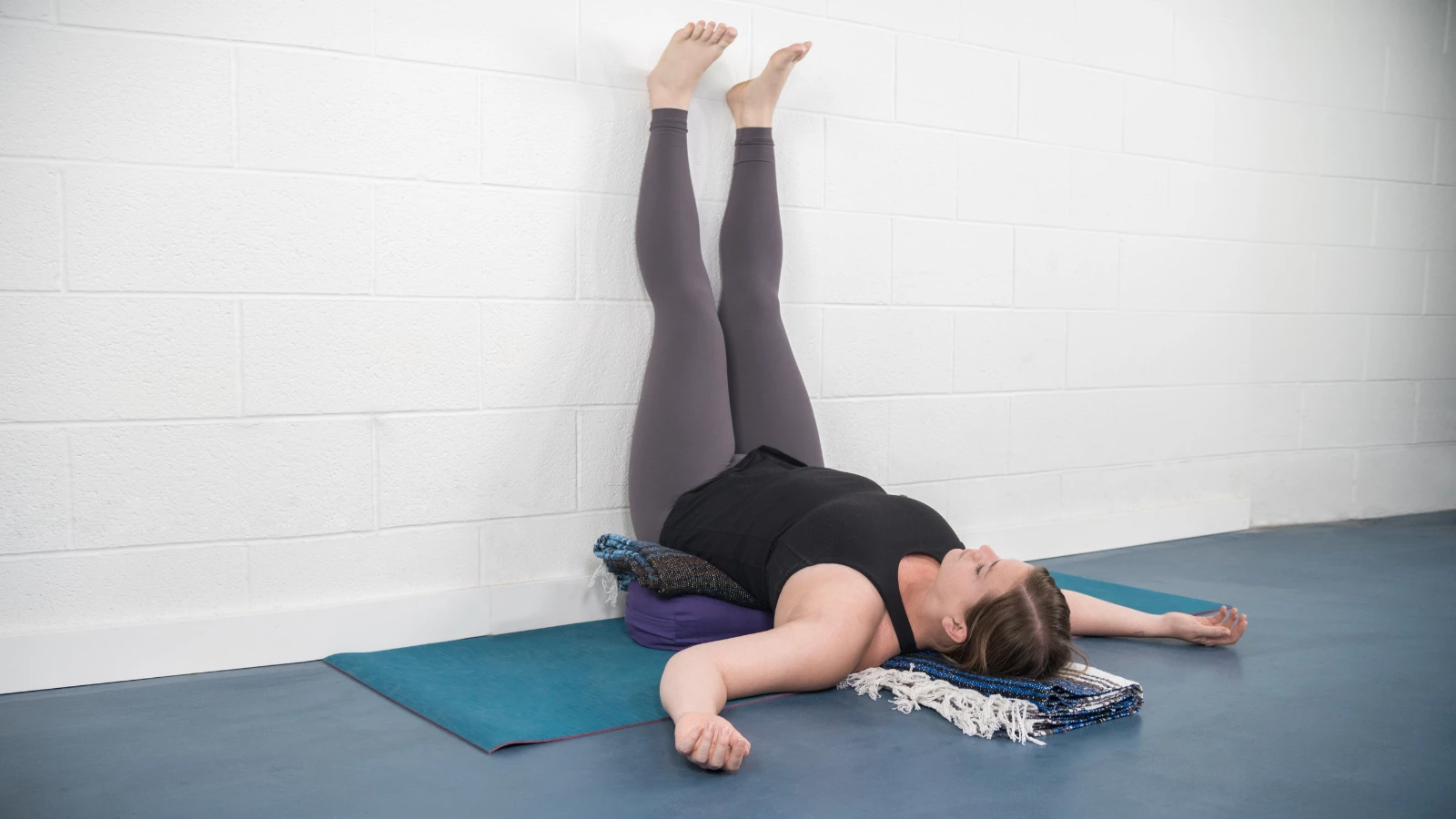Struggle with SI Joint Pain? Avoid These 4 Common Yoga Mistakes

Article At A Glance
Struggle with low back pain? It could be your SI joint. Some 15 to 30 percent of low back problems are related to sacroiliac (SI) joint dysfunction. And while one might think that yoga could help, some types of yoga practice actually can cause sacroiliac joint pain. Learn how to promote SI joint health in yoga and find pain relief.
Lower back pain is shockingly common in the general adult population. The root cause of 15 to 30 percent of low back problems is related to sacroiliac (SI) joint pain. Despite how common it is, SI joint problems are often not correctly diagnosed as such. Do you consider SI joint health in yoga practice?
One might think that yoga could help, and in some cases it most likely does. Yet, due to certain trends in practice and teaching, and in vinyasa-style yoga in particular, SI problems are a leading repetitive stress issue among dedicated yogis. How can yogis reduce SI joint pain, especially in vinyasa-style yoga?
Can Yoga Contribute to SI Joint Pain?
I took a refresher teacher training in the summer of 2020. When we were discussing twists, our teacher trainer shared an analogy with respect to the hips and the spine. When you transplant, you don’t pull a plant up directly by the root. Instead, you take with it the soil that it’s already in.
How does this connect with SI joint health in yoga practice, you may ask? Vinyasa-style practice can negatively impact sacroiliac joint health when it strains the joint’s stabilizers by forcing the pelvis and sacrum (which meet at the SI joint) in opposing directions. Due to the size and shape of the lumbar vertebrae’s facet joints, the lumbar spine (the lower back) is designed to twist little to not at all. So, something has to give to make the twist happen, and the body asks sacroiliac stabilizers to do so. This can cause pain and functional issues over time.

Those stabilizers are primarily ligaments, but muscles and fascia also help out. A wiser approach is to move these bones and stabilizers together by allowing the pelvis to move in the direction of the twist, thus, moving the soil and the plant together.
The plant-soil analogy aligns with an important focus on stability over mobility. The sacroiliac joint is part of a stabilizing system at the very base of the spine, designed to absorb shock along with movement rather than provide mobility and dexterity.
If we push it toward mobility at the expense of stability, we’re going against the body’s natural form and function. That can lead to pain, numbness/tingling, and tenderness to the touch.
How to Reduce SI Joint Pain in Yoga Practice
Here are four ways to nurture, rather than jeopardize, sacroiliac joint health in your vinyasa yoga practice:
1. Avoid More Than 3-5 Asymmetrical Poses In A Row
If you’ve practiced vinyasa-style yoga with any regularity, you’re familiar with sequences that include many different poses. These sequences are often variations on basic Sun Salutation (Surya Namaskar) frameworks. Therefore, we practice each sequence on one side of the body and then move to the other side.
That structure keeps the work on each side of the body even. Moving through many poses in one sequence can additionally feel dynamic and just plain fun!

There’s a significant downside there, however, one that brings risk for sacroiliac strain. With asymmetrical poses, one side of the sacroiliac joint is fixed while the other moves along with the spine in whatever direction necessary to execute the pose at hand. With long sequences of asymmetrical poses, the spine moves in various directions at various degrees of motion. This causes one side of the sacroiliac joint to remain fixed while the other moves.
That can ask a lot of the side of the sacroiliac joint that’s moving and therein pull at the ligaments, muscles, and fascia that we need to keep the SI joint stable. That makes those stabilizers lax enough to potentially cause instability at the joint. (Generally speaking, there’s an inverse relationship between mobility and stability).
That laxity can be particularly problematic with ligaments, the main stabilizers of the SI joint). They lack a nutritive blood supply, so they stay that way once they’re overstretched to a certain length.
In another way of looking at it, fixing one side of the sacroiliac joint while the other moves is little by little separating the plant from the soil. This can cause significant problems if done time after time, practice after practice.
2. Practice Mindful Alternatives
If we’re a yogi who loves to flow (and I’m one of them), how can we avoid doing these sorts of long, potentially unsafe asymmetrical sequences? We can probably do so most directly if we’re instructors, simply by sequencing fewer symmetrical poses together on one side of the body.
Break up asymmetrical pose sequences flowing through Four-Limbed Staff Pose (Chaturanga Dandasana) to Upward-Facing Dog Pose (Urdhva Mukha Svanasana) or a prone pose, or simply shifting from Plank Pose (Phalakasana) to Downward-Facing Dog Pose (Adho Mukha Svanasana), and then doing the other side before adding on more poses. Three poses on one side is a good guideline, and five is a reasonable maximum.

We can bring the same principles to our home practice and how we choose which instructors with whom to practice. That can encourage SI joint health in our flow-style classes and home practices.
3. Allow Slight Rotation of the Pelvis In Twists
This is the sacroiliac safety guideline to which my teacher trainer was directly referring that day. It’s the one for which the plant/soil analogy makes the most sense. Is a Revolved Chair Pose (Parivrtta Utkatasana) part of your practice? How about seated twists or twists from a Lunge Pose (Anjaneyasana)?
These are common poses in vinyasa-style yoga. You may very well have heard your instructor tell you to keep the hips even and stable and only move the spine in these poses. Or if you teach, you may have given this cue yourself. I know that I used to before I knew a big reason for not doing so.
The reasoning behind that cue seems sound enough. If some of the twist is happening in the pelvis, there’s less twist for the spine (where we want it). But remember that the lumbar spine doesn’t twist. So if the pelvis doesn’t twist with the spine, the sacrum will have to twist within the ilium, causing those SI joint stabilizers to stretch more. Over time, that can lead to less stability in the joints. Bring the soil with the plant, because they’re meant to move together.
If you teach vinyasa, you can instruct your students to allow the pelvis to move in the direction of twists. Alternatively, refrain from telling them to keep their hips fixed when they twist, and their bodies will know what to do. The exception to this is if your students have already heard the instruction to square their hips from you or from other teachers. If that’s the case, they’ll tend to square their hips automatically. So you’ll need to reeducate them. Make sure to allow yourself to rotate your pelvis in your home practice as well.
If an instructor cues you to keep your hips fixed while you twist, know that you can make a different choice. You, or your students when/if you’re teaching, might twist a little less deeply, but that’s a small thing to sacrifice to keep the SI joint safe and healthy in yoga practice.
4. Practice Stabilizing Yoga Poses
A good way to avoid overexerting any particular part of the body (which, over time, can cause repetitive stress issues) is to practice a balanced set of yoga postures that gently work and challenge the whole body. Stabilizing poses can also help to balance out flexibility work. This helps avoid stretching to the point of causing hypermobility.
Luckily, vinyasa-style posture practice is conducive to balanced sequences of many postures. It also offers plenty of stabilizing poses to choose from. Yet, whether you’re practicing on your own or sequencing for your students, it does take some intention and creativity to remember to include both stabilizing and mobilizing poses.
Bonus Tips To Reduce SI Joint Pain in Yoga
Symmetrical poses are great for stabilizing and resetting the sacroiliac joint.

- Gentle, prone backbends, including Baby Cobra Pose (Ardha Bhujangasana) and Locust Pose (Salabhasana), are a helpful subfamily of symmetrical poses for sacroiliac joint health. Bird Dog Pose (Parsva Balasana) similarly engages the fascial subsystem that stabilizes the SI joint. There are a couple of stabilizing nuances to keep in mind when practicing these poses. Strengthening the latissimus dorsi muscles on the sides of the back that act on the shoulder joint is one way. Strengthening the glutes, as well as simultaneously engaging the pelvic floor muscles and back extensors can enhance the SI joint stabilizing effects of these poses.
- Warrior Poses (Virabhadrasana) and one-legged standing balances are effective as well, so long as you don’t practice them in a long, long string of poses on each side (see approach #1).
- Lower abdominal and back muscles support the pelvic area. So comprehensive, integrated core-strengthening work, including the back, glutes, obliques, and deep core muscles, is important for SI joint health in yoga practice.
- Take particular care with seated forward bends and twists, as the pelvis is in a position that makes it even more vulnerable to sacroiliac strain. Avoid overstretching sacroiliac stabilizers by not holding seated forward folds for too long. Five breaths or so is generally plenty. With twists, remember to move the pelvis and spine together. Liberally use props for additional support.

- Ending practice with the Legs-Up-the-Wall Pose (Viparita Karani) can be an incredible reset for the sacroiliac joints. Gravity guides the upper thigh bones deeper into the sockets and thereby resets sacroiliac joint stabilizers from any stretching that practice might have asked of them.
When you practice these few simple steps, you can smile a little, knowing that you’re making choices that support rather than harm your sacroiliac joint. You’re keeping the soil and pot together, allowing them to nurture each other and you to enjoy the beautiful bloom of good health that can result. At the very least, you can keep your SI joint healthy in yoga practice!
Also, read...
Happy Hips: 5 Strategies to Stabilize Your SI Joints in Yoga
Tricky Triangle Pose: Learn to Protect Your SI Joints
Safe Twisting: Rotate the Spine, Not the SI Joint
Related courses
Breath as Medicine: Yogic Breathing for Vital Aging
Yoga and Myofascial Release: Releasing Chronic Tension with the Bodymind Ballwork Method
Yoga and Detoxification: Tips for Stimulating Lymphatic Health

Kathryn Boland is an RCYT and R-DMT (Registered Dance/Movement Therapist). She is originally from Rhode Island, attended The George Washington University (Washington, DC) for an undergraduate degree in Dance (where she first encountered yoga), and Lesley University for an MA in Clinical Mental Health Counseling, Expressive Therapies: Dance/Movement Therapy. She has taught yoga to diverse populations in varied locations. As a dancer, she has always loved to keep moving and flowing in practicing more active Vinyasa-style forms. Her interests have recently evolved to include Yin and therapeutic yoga, and aligning those forms with Laban Movement Analysis to serve the needs of various groups (such as Alzheimer’s Disease patients, children diagnosed with ADHD, PTSD-afflicted veterans – all of which are demographically expanding). She believes in finding the opportunity within every adversity, and doing all that she can to help others live with a bit more breath and flow!



